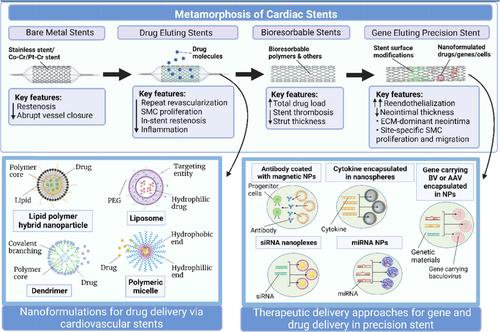当前位置:
X-MOL 学术
›
WIREs Nanomed. Nanobiotechnol.
›
论文详情
Our official English website, www.x-mol.net, welcomes your feedback! (Note: you will need to create a separate account there.)
Nanotechnology in development of next generation of stent and related medical devices: Current and future aspects
WIREs Nanomedicine and Nanobiotechnology ( IF 8.6 ) Pub Date : 2024-03-25 , DOI: 10.1002/wnan.1941 Paromita Islam 1 , Sabrina Schaly 1 , Ahmed Kh. Abosalha 1, 2 , Jacqueline Boyajian 1 , Rahul Thareja 1 , Waqar Ahmad 1 , Dominique Shum‐Tim 3 , Satya Prakash 1
WIREs Nanomedicine and Nanobiotechnology ( IF 8.6 ) Pub Date : 2024-03-25 , DOI: 10.1002/wnan.1941 Paromita Islam 1 , Sabrina Schaly 1 , Ahmed Kh. Abosalha 1, 2 , Jacqueline Boyajian 1 , Rahul Thareja 1 , Waqar Ahmad 1 , Dominique Shum‐Tim 3 , Satya Prakash 1
Affiliation

|
Coronary stents have saved millions of lives in the last three decades by treating atherosclerosis especially, by preventing plaque protrusion and subsequent aneurysms. They attenuate the vascular SMC proliferation and promote reconstruction of the endothelial bed to ensure superior revascularization. With the evolution of modern stent types, nanotechnology has become an integral part of stent technology. Nanocoating and nanosurface fabrication on metallic and polymeric stents have improved their drug loading capacity as well as other mechanical, physico-chemical, and biological properties. Nanofeatures can mimic the natural nanofeatures of vascular tissue and control drug-delivery. This review will highlight the role of nanotechnology in addressing the challenges of coronary stents and the recent advancements in the field of related medical devices. Different generations of stents carrying nanoparticle-based formulations like liposomes, lipid-polymer hybrid NPs, polymeric micelles, and dendrimers are discussed highlighting their roles in local drug delivery and anti-restenotic properties. Drug nanoparticles like Paclitaxel embedded in metal stents are discussed as a feature of first-generation drug-eluting stents. Customized precision stents ensure safe delivery of nanoparticle-mediated genes or concerted transfer of gene, drug, and/or bioactive molecules like antibodies, gene mimics via nanofabricated stents. Nanotechnology can aid such therapies for drug delivery successfully due to its easy scale-up possibilities. However, limitations of this technology such as their potential cytotoxic effects associated with nanoparticle delivery that can trigger hypersensitivity reactions have also been discussed in this review.
中文翻译:

纳米技术开发下一代支架及相关医疗器械:当前和未来方面
在过去三十年中,冠状动脉支架通过治疗动脉粥样硬化,特别是通过预防斑块突出和随后的动脉瘤,挽救了数百万人的生命。它们减弱血管 SMC 增殖并促进内皮床重建,以确保良好的血运重建。随着现代支架类型的发展,纳米技术已成为支架技术不可或缺的一部分。金属和聚合物支架上的纳米涂层和纳米表面制造提高了它们的载药能力以及其他机械、物理化学和生物特性。纳米特征可以模仿血管组织的天然纳米特征并控制药物输送。本综述将重点介绍纳米技术在应对冠状动脉支架挑战方面的作用以及相关医疗器械领域的最新进展。讨论了携带脂质体、脂质聚合物杂化纳米颗粒、聚合物胶束和树枝状聚合物等纳米颗粒制剂的不同代支架,强调了它们在局部药物输送和抗再狭窄特性中的作用。嵌入金属支架中的紫杉醇等药物纳米粒子被视为第一代药物洗脱支架的一个特征。定制的精密支架可确保纳米颗粒介导的基因的安全输送或通过纳米制造的支架协调转移基因、药物和/或生物活性分子(如抗体、基因模拟物)。纳米技术由于其易于扩大规模的可能性,可以帮助此类疗法成功地进行药物输送。然而,该技术的局限性,例如与纳米颗粒递送相关的潜在细胞毒性作用,可能引发超敏反应,本综述也进行了讨论。
更新日期:2024-03-27
中文翻译:

纳米技术开发下一代支架及相关医疗器械:当前和未来方面
在过去三十年中,冠状动脉支架通过治疗动脉粥样硬化,特别是通过预防斑块突出和随后的动脉瘤,挽救了数百万人的生命。它们减弱血管 SMC 增殖并促进内皮床重建,以确保良好的血运重建。随着现代支架类型的发展,纳米技术已成为支架技术不可或缺的一部分。金属和聚合物支架上的纳米涂层和纳米表面制造提高了它们的载药能力以及其他机械、物理化学和生物特性。纳米特征可以模仿血管组织的天然纳米特征并控制药物输送。本综述将重点介绍纳米技术在应对冠状动脉支架挑战方面的作用以及相关医疗器械领域的最新进展。讨论了携带脂质体、脂质聚合物杂化纳米颗粒、聚合物胶束和树枝状聚合物等纳米颗粒制剂的不同代支架,强调了它们在局部药物输送和抗再狭窄特性中的作用。嵌入金属支架中的紫杉醇等药物纳米粒子被视为第一代药物洗脱支架的一个特征。定制的精密支架可确保纳米颗粒介导的基因的安全输送或通过纳米制造的支架协调转移基因、药物和/或生物活性分子(如抗体、基因模拟物)。纳米技术由于其易于扩大规模的可能性,可以帮助此类疗法成功地进行药物输送。然而,该技术的局限性,例如与纳米颗粒递送相关的潜在细胞毒性作用,可能引发超敏反应,本综述也进行了讨论。



























 京公网安备 11010802027423号
京公网安备 11010802027423号